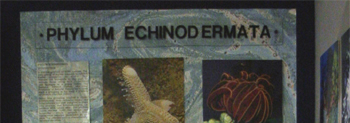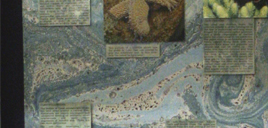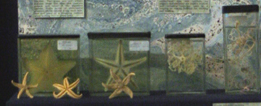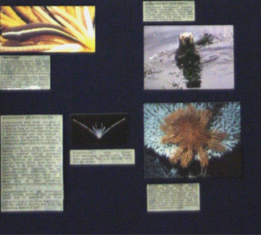
PHYLUM ECHINODERMATA
A marine phylum of 6000 species, this is the only group of animals to exhibit radial symmetry as adults. The name Echinodermata, i.e. animals with spiny skin, derives from the spines and tubercles, which project from calcareous ossicles embedded in the skin. The ossicles form a characteristic internal skeleton. Their spines and toxic substances in their body walls are used to deter their many predators.
The phylum comprises four very distinct classes of organisms: starfishes, basket stars and brittle stars; sea urchins; sea cucumbers; sea lilies and feather stars. Although very diverse in body form, all echinoderms possess the typical pentaradial symmetry of the phylum and their limbs and organs generally exist in multiples of five. As adults, echinoderms usually lack an anterior head region.
All echinoderms possess a unique water vascular system, found only in this phylum. This consists of fluid-filled chambers, vessels and muscular podia (feet) connected to the outside by a short canal and opening, the madreporite. The podia are used hydrostatically in feeding and for locomotion. Gas exchange takes place over the body or through feathery gills.
Echinoderms are generally male or female. The gametes are usually expelled into the sea where fertilisation occurs. Typically the eggs develop into planktonic, ciliated, bilaterally symmetrical larva with each class having its own characteristic type of larva.
Development and deuterostome affiliations
It was recognised that echinoderms, hemichordates and chordates – including vertebrates – were members of one evolutionary line, the deuterostomes, when all three groups were found to share the following four, basic developmental features:
- All are triploblastic: their three-layered bodies derive from three germ layers.
- All are enterocoelous coelomates: their mesodermal layers arise by enterocoely i.e. evagination of the embryonic gut to form two pouches. The walls of the pouches become mesoderm; the internal spaces, the coelom.
- The eggs of all undergo radial indeterminate cleavage: the axes of early divisions are as right angles to each other; the fate of the ensuing cells is not fixed for some time.
- All are deuterostomes (second mouth): mouth and anus develop in two distinct sites in the embryo.
The split between the deuterostome and the protostome line of molluscs, annelids and arthropods pre-dated the earliest known fossils. The exact nature of their common ancestor is therefore unknown. A flat-worm is a possibility.
|
|||||||||||||||||||||||||||||||














